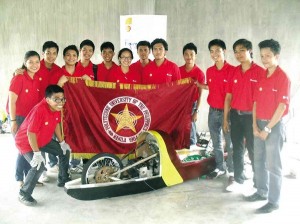Engineering students from colleges and universities in Metro Manila and Cebu put theory into practice to build “fuel-efficient and environment-friendly” cars for the Asian leg of the Shell Eco-Marathon.
This year’s competition, developed to “encourage young student engineers … to design, build and test energy-efficient vehicles,” will be held on July 4-7 at Sepang International Circuit in Kuala Lumpur, Malaysia.
Nine teams from top engineering schools in the country revved up the custom-made engines of their prototype and urban concept cars at Clark International Speedway in Pampanga, a month before the Malaysia competition.
Participating schools this year are Mapua Institute of Technology (MIT), De La Salle University (DLSU), University of Santo Tomas (UST), Don Bosco Technical College, Technological Institute of the Philippines (TIP) Quezon City and Manila campuses, and Polytechnic University of the Philippines (PUP).
Another team from the University of San Carlos held a separate trial in Cebu.
Students, with the help of their advisers, built the eco-friendly cars themselves, from conceptualization to actual assembly, choosing from a variety of energy sources to power the engines such as gasoline, diesel, bio-fuel, gas to liquid, electric battery, etc.
On a concrete racetrack, students took their cars for a test drive. Some tweaking and fine-tuning were done before and after the first run to make sure the driver was comfortable inside the vehicle, to fix any glitches and improve the efficiency of the automobile.
MIT mechanical engineering (ME) student Jose Diwa showed off one of his school’s two entries, “Haribon.” The urban concept car’s engine runs on diesel and has a mileage of 70 kilometers per liter. It has wet weather capability and, like a regular car, has a wiper so it can run even when it rains.
Recycled and reused
Diwa said Haribon was made mostly from recycled materials, like aluminum plates. The engine was taken from an old motorcycle and the chassis came from MIT’s first urban concept entry in 2011.
Although the materials used were salvaged from other vehicles, Diwa made the assurance that the car was safe.
“Our safety features include turn indicator signals, hazard lights and a horn. We also have two emergency stops, both internal and external, and a separate manual engine stop,” Diwa said.
MIT won several safety awards in previous Shell Eco-Marathon competitions but this year, it faces strong competition from UST for the safety award. The university’s entry, “T400h,” a hybrid automobile, has less smoke emission with its gasoline and electricity-powered engine. With a mileage of 700 kilometers per liter, the vehicle has a safety feature to protect the driver in case of a collision.
Jerome Bundalian, a graduating ME student and part of the team that created the T400h, explained that the car has a collapsible steering column. It is automatically dislodged upon
collision so it would not hit the driver in the chest.
The cars took months, even a year, to complete.
It took the TIP-QC team almost a year to finish their battery-powered car “Prevo II” as they had to raise around P400,000.
Money woes
“[O]ur project got delayed because of financial problems,” said Blue Jay Calalang, a graduating electrical engineering (EE) student. “We shouldered the cost of everything when we were just starting. When we tried to add the expensive parts, the engine and the battery, that’s when we asked for support from the school.”
Financial woes also bugged the team from PUP, the only state university in the Philippine delegation.
Carl Inopia, a graduating ME student from PUP, said his team had to spend for the materials of their prototype car “Tanglaw.” They spent at least P100,000 for the automobile. To finish the vehicle, they had to find sponsors. They also asked friends to provide the additional manpower needed free of charge.
Inopia added that, because of lack of funds, some members of his team would not be able to go to Malaysia.
Despite the problems, the students were happy to have been able to participate in the contest.
“We want to experience [the race] and bring pride to our school,” said Arlyn Gayomali, an EE student from TIP-QC.
Calalang said the Shell Eco-Marathon provides them an avenue to use what they learned in school and to be multidisciplinary. “We had to apply mechanical engineering, management and finance as well (for the project),” Calalang said.
